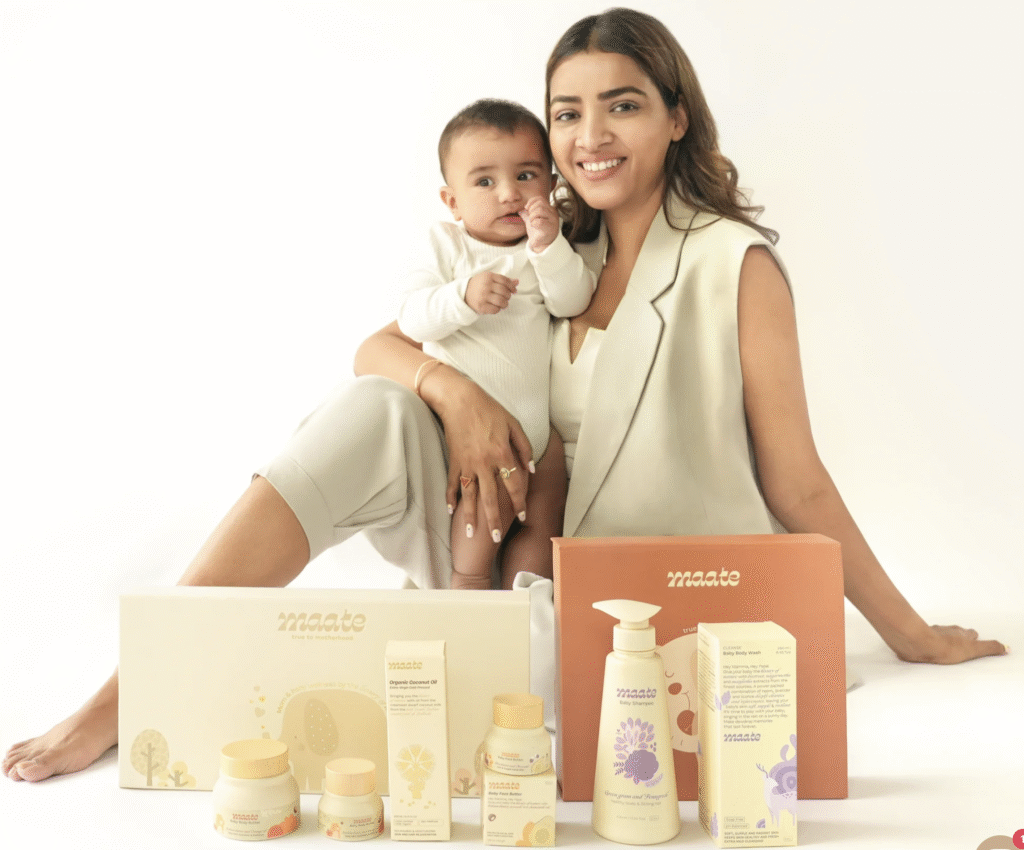
How a Cricket Legend and His Co-Founder Wife Turned Baby Oil into a Cultural Crusade
On a sultry July morning in Delhi, Suresh Raina—once a fixture of India’s cricketing pantheon—stood before a modest film crew in a bright, airy nursery. With his trademark grin replaced by a furrowed brow, he held aloft a bottle of amber-tinted baby oil and asked, as though addressing an unruly bowling attack, “Do you even know what’s in your baby’s lotion?” Across town, Priyanka Raina, co-founder of Maate, watched footage on her laptop, nodding approvingly.
What began as an off-hand question in a department-store aisle has since blossomed into #EffectiveBabyCare×Maate, a digital campaign that has turned a simple product launch into a broader cultural conversation about transparency, trust, and the future of Indian parenting.
A Cultural Paradox, Spotted at Aisle C5
The Raina campaign rests on a seductive contradiction. India’s millennial parents—some 440 million strong—are renowned for their research prowess: they pore over glycemic indices, debate the merits of Montessori pedagogy, and consult peer-reviewed sleep-training protocols. Yet when it comes to baby-care ingredients—sodium lauryl sulfate, phenoxyethanol, mineral oil—their curiosity often wilts.
Priyanka Raina first sensed this disparity as a new mother in 2019, flipping through face-cream labels with greater voracity than those on her infant’s lotion. That epiphany became Maate’s calling card: label literacy as empowerment.
This insight proved a masterstroke in a market projected to swell from $7.3 billion in 2024 to $26.3 billion by 2030. With average Indian households shrinking from 2.68 children in 2005 to 1.99 in 2023, parents allocate more resources—and anxieties—to each child. Maate’s Ayurvedic-meets-science formulations, drawing on white lotus and chamomile, offered an ideal bridge between ancestral wisdom and modern safety standards.
Founders as Faces of Authenticity

The Rainas present Maate’s signature baby-care gift set, underscoring their collaborative ethos
In an era where influencers trade authenticity like currency, the Rainas wagered their own reputations. Priyanka, with her measured calm and scientific curiosity, and Suresh, whose celebrity still commands stadium-sized attention, embodied the brand’s dual promise: efficacy and integrity. Their willingness to appear onscreen—script in hand, occasional ad-lib—lent a sincerity that even the savviest consumers could detect.
Yet this founder-centric strategy is not without peril.
When a brand’s greatest asset is its leadership, any misstep—be it a social media faux pas or a shift in personal priorities—can ripple through the business. As one marketing executive put it, “Authenticity is precious but fragile; anchoring it to individuals demands rigorous succession planning.”
Digital Storytelling: The Cricket Analogy
The campaign’s signature ad marries cricketing metaphor with parental introspection. Suresh stands in a nursery crib as though at the crease, batting stance firm, gaze earnest.
He rattles off batting averages—600 ODI runs at an average of 47.08—then pivots: “But do you know what’s on the back of that bottle?” The juxtaposition jolts viewers into self-reflection: if we can memorise sports statistics, why not decode chemical names?
This narrative proved effortlessly portable. On Instagram, the clip played on loop in Stories; on YouTube, it invited parents to pause, scribble down ingredients, and share their discoveries. The result was a 35 percent spike in Maate’s online sales within two months of launch—proof that a resonant story can drive both engagement and conversion.
The Perils of Educational Overload
Maate’s bold “defensive consumption coaching” thrives on information. Yet there is such a thing as too much data. Some parents reported ingredient-label fatigue, a sensation akin to deciphering a foreign language without glossary. Critics argue that fear-based messaging—warning of parabens and phthalates—treads close to scaremongering.
When campaigns challenge behaviours too forcefully, they risk triggering reactance, a psychological pushback against perceived manipulation.
One pediatric dermatologist in Bangalore observed, “Education is vital, but if your messaging leans into alarmism, you may end up alienating the very audience you aim to empower.” For digital marketers, the takeaway is clear: balance depth with digestibility. Infographics, interactive quizzes, and tiered content can prevent information burnout while preserving educational integrity.
Bridging Brand Building and Performance Marketing
Perhaps the campaign’s subtlest triumph lies in dissolving the false dichotomy between brand building and performance marketing. Maate’s educational videos—rich in context and anecdote—functioned as both awareness drivers and conversion engines.
By weaving sales hooks into a broader cultural narrative, the Rainas achieved what few campaigns manage: an immediate return on ad spend alongside enduring brand equity.
This hybrid approach demands more sophisticated attribution models. Relying solely on last-click conversions understates the long-term value of brand lift. Marketers should embrace omnichannel measurement—blending CRM data, sentiment analysis, and cohort-based lifetime-value tracking—to capture the full spectrum of campaign impact.
When Competitive Imitation Looms
The very success of Maate’s transparency claim has prompted larger incumbents to scramble. Johnson & Johnson and Himalaya have since relaunched “ingredient-aware” product lines, wielding their deep pockets to tout similar benefits.
This phenomenon—authenticity commoditisation—reveals a critical lesson: differentiation must be continuously refreshed.
For Maate, the next frontier lies in proprietary research and community building. By commissioning independent clinical studies on Ayurvedic extracts and cultivating online forums for peer-to-peer label-reading, the brand can reinforce its leadership in the space. In digital marketing parlance, innovation sustains authenticity; stagnation invites parody.
Scaling Authenticity Beyond Founders
As Maate contemplates expansion, it confronts a classic growth dilemma: how to preserve founder authenticity when the Rainas cannot front every campaign.
The solution may lie in formalising an authenticity framework—a set of brand principles, tone-of-voice guidelines, and community rituals that transcend individual personalities.
This institutional scaffolding allows new spokespeople—product scientists, paediatric advisors, even passionate parents—to carry the torch without feeling like pale imitations.
A New Playbook for Digital Marketers
The Maate odyssey offers a rich vein of insights for marketers everywhere:
In the age of defensive consumption, brands must become educators without becoming alarmists.
Founder-led storytelling can cut through clutter, but only when paired with robust risk-management and succession planning.
True omnichannel success requires merging brand and performance metrics into unified attribution models.
Authenticity is not a static trophy but a moving target—demanding continuous innovation in product, narrative, and community.
As the digital marketing landscape grows ever more complex, the Rainas remind us that even baby oil can serve as a catalyst for cultural change—provided the story is told with equal measures of insight, empathy, and perhaps just a dash of cricketing flair.
In the end, Maate’s campaign did more than shift market share; it nudged an entire generation of parents toward a new habit—reading labels as compulsively as scorecards. And for digital marketers, that habit may well become the ultimate metric of success.
